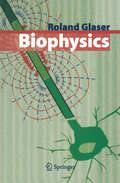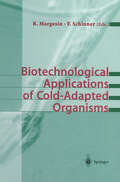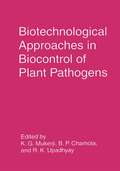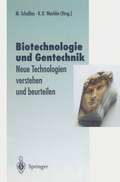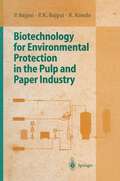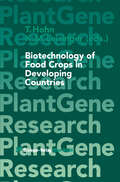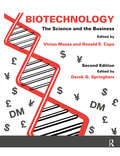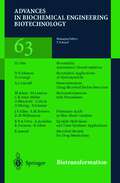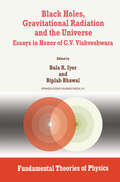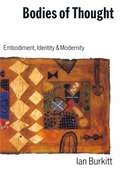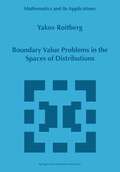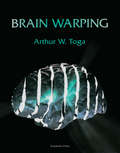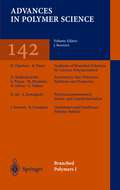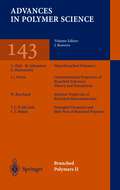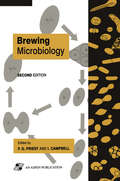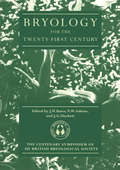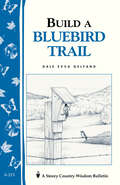- Table View
- List View
Biophysics
by Roland GlaserBiophysics is the science of physical principles underlying the "phenomenon of life" on all levels of organization. This book begins by explaining molecular and ionic interactions, movements, excitation and energy transfer, and the self-organization of supramolecular structures. Then the biological organism is introduced as a non-equilibrium system. Finally, system analyses are discussed as well as environmental biophysics, ecological interactions, growth, differentiation, and evolution. A growing number of applications in biotechnology are based on these biophysical concepts.
Biophysics of Computation: Information Processing in Single Neurons (Computational Neuroscience Series)
by Christof KochNeural network research often builds on the fiction that neurons are simple linear threshold units, completely neglecting the highly dynamic and complex nature of synapses, dendrites, and voltage-dependent ionic currents. Biophysics of Computation: Information Processing in Single Neurons challenges this notion, using richly detailed experimental and theoretical findings from cellular biophysics to explain the repertoire of computational functions available to single neurons. The author shows how individual nerve cells can multiply, integrate, or delay synaptic inputs and how information can be encoded in the voltage across the membrane, in the intracellular calcium concentration, or in the timing of individual spikes. Key topics covered include the linear cable equation; cable theory as applied to passive dendritic trees and dendritic spines; chemical and electrical synapses and how to treat them from a computational point of view; nonlinear interactions of synaptic input in passive and active dendritic trees; the Hodgkin-Huxley model of action potential generation and propagation; phase space analysis; linking stochastic ionic channels to membrane-dependent currents; calcium and potassium currents and their role in information processing; the role of diffusion, buffering and binding of calcium, and other messenger systems in information processing and storage; short- and long-term models of synaptic plasticity; simplified models of single cells; stochastic aspects of neuronal firing; the nature of the neuronal code; and unconventional models of sub-cellular computation. Biophysics of Computation: Information Processing in Single Neurons serves as an ideal text for advanced undergraduate and graduate courses in cellular biophysics, computational neuroscience, and neural networks, and will appeal to students and professionals in neuroscience, electrical and computer engineering, and physics.
Biotechnological Applications of Cold-Adapted Organisms
by Rosa Margesin Franz SchinnerHow can industry profit from the biochemical tricks of cold-adapted organisms? This book covers a range of aspects in this fascinating field, from genetic tools to environmental biotechnology.
Biotechnological Approaches in Biocontrol of Plant Pathogens
by K. G. Mukerji B. P. Chamola Rajeev K. UpadhyayBiological control offers a promising alternative to chemical control which can have adverse environmental implications. This volume contains 16 articles describing the most modern topics in biocontrol of plant pathogens, including risk analysis for the release of microbial antagonists, genetic engineering and application of tissue culture.
Biotechnologie und Gentechnik: Neue Technologien verstehen und beurteilen (Veröffentlichungen der Akademie für Technikfolgenabschätzung in Baden-Württemberg)
by U. HafnerModerne Technologien mit ihrer typischen Komplexität stellen eine Herausforderung an die Entwicklung von Urteils- und Handlungsfähigkeit in der Schule dar, weil sich das Wissen auf dem Gebiet moderner Technologieentwicklung mit einer enormen Geschwindigkeit weiterentwickelt, weil strategisches Denken in Bezug auf Zielsetzungen und Wahlmöglichkeiten für die Lösung komplexer Probleme, z.B. in der Landwirtschaft, Pharmazie oder Medizin, benötigt wird und weil die Prüfung der damit verbundenen Zielsetzungen auf Werte und Normen erforderlich ist, die der Bildung eines eigenständigen Urteils- und Handlungsvermögens zugrunde gelegt werden können. Das Buch läßt Fachleute zu Wort kommen, die in Biotechnologie und Gentechnik zur Weiterentwicklung des Wissens beitragen, sich damit auseinandersetzen, wie schulische Bildung zur Entwicklung eines angemessenen Technologieverständnisses Grundlagen legt und wie der Diskurs zwischen Laien und Experten ermöglicht werden kann.
Biotechnology for Environmental Protection in the Pulp and Paper Industry
by P. Bajpai R. KondoPulp and paper production has increased globally and will continue to increase in the near future. Approximately 155 million tons of wood pulp is produced worldwide and about 260 million is projected for the year 2010. To be able to cope with increasing demand, an increase in productivity and improved environmental performance is needed as the industry is also under constant pressure to reduce and modify environmental emissions to air and water. The authors give updated information on various biotechnological processes useful in the pulp and paper industry which could help in reducing the environmental pollution problem, in addition to other benefits. Various chapters deal with the latest developments in such areas as raw material preparation, pulping, bleaching, water management, waste treatment and utilization. The book also covers the environmental regulations in various parts of the world as well as the role of biotechnology in reducing environmental problems.
Biotechnology of Food Crops in Developing Countries (Plant Gene Research)
by T. Hohn K. M. LeisingerRecent advances in gene technology, plant transformation, and the growing knowledge of DNA sequences of plants as well as of their most important parasites and symbionts offer many interesting prospects for the breeding of new crop varieties. This was not only recognized by the major seed companies, but also by the governments of developing countries and by worldwide foundations supporting their agriculture. The know-how gained by the seed companies on crops important for the agricultural industry in developed countries could easily be provided for free to the international and national organizations dedicated to development of crops important in the third world. Results obtained worldwide become easily available to everybody through the scientific literature. Likewise, agricultural research in, e.g., the USA or Europe profits from the natural plant gene pool available in the third world. All this definitely provides for the possibility of fast change, new prosperity and security of food supply in the whole world, if properly applied. The fast development also asks for ethical and sociopolitical considerations, whereby not doing the right can be as much a mistake as doing the wrong.
Biotechnology - The Science and the Business
by Vivian Moses Ronald E. Cape Derek G. SpringhamBiotechnology has not stood still since 1991 when the first edition of Biotechnology - The Science and the Business was published. It was the first book to treat the science and business of technology as an integrated subject and was well received by both students and business professionals. All chapters in this second edition have been updated and revised and some new chapters have been introduced, including one on the use of molecular genetic techniques in forensic science. Experts in the field discuss a range of biotechnologies, including pesticides, the flavor and fragrance industry, oil production, fermentation and protein engineering. On the business side, subjects include managing, financing, and regulation of biotechnology. Some knowledge of the science behind the technologies is assumed, as well as a layperson's view of buying and selling. As with the first edition, it is expected that this book will be of interest to biotechnology undergraduates, postgraduates and those working in the industry, along with students of business, economics, intellectual property law and communications.
Biotechnology - The Science and the Business
by Derek G. Springham Vivian Moses Ronald E. CapeBiotechnology has not stood still since 1991 when the first edition of Biotechnology - The Science and the Business was published. It was the first book to treat the science and business of technology as an integrated subject and was well received by both students and business professionals. All chapters in this second edition have been updated and revised and some new chapters have been introduced, including one on the use of molecular genetic techniques in forensic science. Experts in the field discuss a range of biotechnologies, including pesticides, the flavor and fragrance industry, oil production, fermentation and protein engineering. On the business side, subjects include managing, financing, and regulation of biotechnology. Some knowledge of the science behind the technologies is assumed, as well as a layperson's view of buying and selling. As with the first edition, it is expected that this book will be of interest to biotechnology undergraduates, postgraduates and those working in the industry, along with students of business, economics, intellectual property law and communications.
Biotransformations (Springer Desktop Editions In Chemistry Ser.)
by K. FaberWhereas the hydrolases such as proteases, esterases and lipases are sufficiently well researched to be applied in every standard laboratory, other types of enzymes are still waiting to be discovered with respect to their applicability in organic-chemistry transformations on a preparative scale. This latter point is stressed here, with the focus on the newcomer-enzymes'which show great synthetic potential.
Bioverfahrensentwicklung: Aufgabensammlung Für Auslegung, Betrieb Und Kostenanalyse
by Winfried StorhasBioverfahren haben sich in vielen Bereichen als überlegene Alternativen zu klassischen Produktionsverfahren etabliert, und ihre Bandbreite wird immer größer. Die Biotechnologie, insbesondere unter Einbezug der Gentechnik, hat zweifellos Zukunft. Die schnelle und effiziente Umsetzung von Forschungsergebnissen in wirtschaftliche Anwendungen birgt ein enormes wirtschaftliches Potential - und kaum eine andere Branche wächst derzeit so schnell wie die Biotechnologie. Wo sonst gibt es so viele Firmenneugründungen? Doch wie schafft man es, sich schnell zu orientieren? Das vorliegende Buch gibt einen Überblick über die systematische Entwicklung von Bioverfahren. Einer Zusammenstellung der unterschiedlichen Varianten der einzelnen Verfahrensschritte folgen die Beschreibung integrierter Gesamtprozesse, Wirtschaftlichkeitsbetrachtungen und Verfahrensbeispiele. Im Vordergrund stehen dabei Verfahren, die bereits eine wichtige Rolle in der Industrie spielen. Biotechnologie bedeutet Zukunftstechnologie!
Black Holes, Gravitational Radiation and the Universe: Essays in Honor of C.V. Vishveshwara (Fundamental Theories of Physics #100)
by B. R. Iyer B. BhawalOur esteemed colleague C. V. Vishveshwara, popularly known as Vishu, turned sixty on 6th March 1998. His colleagues and well wishers felt that it would be appropriate to celebrate the occasion by bringing out a volume in his honour. Those of us who have had the good fortune to know Vishu, know that he is unique, in a class by himself. Having been given the privilege to be the volume's editors, we felt that we should attempt something different in this endeavour. Vishu is one of the well known relativists from India whose pioneer ing contributions to the studies of black holes is universally recognised. He was a student of Charles Misner. His Ph. D. thesis on the stability of the Schwarzschild black hole, coordinate invariant characterisation of the sta tionary limit and event horizon for Kerr black holes and subsequent seminal work on quasi-normal modes of black holes have passed on to become the starting points for detailed mathematical investigations on the nature of black holes. He later worked on other aspects related to black holes and compact objects. Many of these topics have matured over the last thirty years. New facets have also developed and become current areas of vigorous research interest. No longer are black holes, ultracompact objects or event horizons mere idealisations of mathematical physicists but concrete entities that astrophysicists detect, measure and look for. Astrophysical evidence is mounting up steadily for black holes.
Blackwell's Concise Encyclopedia of Ecology
by Peter P. CalowThe language of ecology has grown rapidly and changed extensively over the last decade. From Arrhenotoky to Psammosere; from the One-tailed test to Zoocoenosis, the Blackwell Concise Encyclopedia of Ecology provides concise, non-technical definitions of over 2000 ecological terms, covering the complete spectrum of pure and applied ecological research. The definitions are drawn from the Encyclopedia of Ecology and Environmental Management, and are fully cross-referenced. This is the most comprehensive and up-to-date dictionary of ecological terms available. It should be invaluable to students and researchers alike. Over 2000 terms defined Avoids technical jargon Fully cross-referenced Includes common abbreviations
Bodenökologie interdisziplinär
by Hartmut Koehler Karin Mathes Broder BrecklingMit diesem Buch sollen aktuelle Entwicklungen der Bodenökologie einem breiteren Publikum zugänglich gemacht und Anknüpfungen zu deren Anwendungsfeldern hergestellt werden. Damit wird ein integrierter Überblick zu bodenökologischer Forschung und Praxis geliefert. Die Autoren stellen ökosystemare und interdisziplinäre Bezüge in den Vordergrund. Hierdurch lassen sich Anknüpfungen zu den lebensweltlichen Aufgabenstellungen und deren Lösungen aus der Perspektive konkreter Berufssituationen herstellen. Das Buch setzt zwar eine gewisse naturwissenschaftliche Vorbildung voraus, ist aber so verfaßt, daß seine Inhalte sowohl von Praktikern als auch Wissenschaftlern anderer Disziplinen nachvollzogen werden können. Eine enge Anbindung an einen fachspezifischen Ausbildungsstand ist nicht gegeben. Erfahrungsberichte aus der Berufspraxis von Bodenökologen runden den Inhalt ab.
Bodies of Thought
by Ian BurkittIn this incisive and truly impressive book, Ian Burkitt critically addresses the dualism between mind and body, thought and emotion, rationality and irrationality, and the mental and the material, which haunt the post-Cartesian world. Drawing on the work of contemporary social theorists and feminist writers, he argues that thought and the sense of being a person is inseparable from bodily practices within social relations, even though such active experience may be abstracted and expanded upon through the use of symbols. Overcoming classic dualisms in social thought, Burkitt argues that bodies are not purely the constructs of discourses of power: they are also productive, communicative, and invested with powerful capacities for changing the social and natural worlds. He goes on to consider how such powers can be developed in more ethical forms of relations and activities.
Boundary Value Problems in the Spaces of Distributions (Mathematics and Its Applications #498)
by Y. RoitbergBrain Function and Oscillations: Volume II: Integrative Brain Function. Neurophysiology and Cognitive Processes (Springer Series in Synergetics)
by Erol BaşarNeuroscience is ripe for a paradigm change as Freeman and Mountcastle describe. Brain Oscillations provide an important key to this change. In this book the functional importance of the brain's multiple oscillations is treated with an integrative scope. According to the author, neurophysiology and cognition demand integrative approaches similar to those of Galilei and Newton in physics and of Darwin in biology. Not only the human brain but also lower brains and ganglia of invertebrates are treated with electrophysical methods. Experiments on sensory registration, perception, movement, and cognitive processes related to attention, learning, and memory are described. A synopsis on brain functions leads to a new neuron assemblies doctrine, extending the concept of Sherrington, and new trends in this field. The book will appeal to scientists and graduate students.
Brain Warping
by Arthur W. TogaBrain Warping is the premier book in the field of brain mapping to cover the mathematics, physics, computer science, and neurobiological issues related to brain spatial transformation and deformation correction. All chapters are organized in a similar fashion, covering the history, theory, and implementation of the specific approach discussed for ease of reading. Each chapter also discusses the computer science implementations, including descriptions of the programs and computer codes used in its execution. Readers of Brain Warping will be able to understand all of the approaches currently used in brain mapping, incorporating multimodality, and multisubject comparisons.Key Features* The only book of its kind* Subject matter is the fastest growing area in the field of brain mapping* Presents geometrically-based approaches to the field of brain mapping* Discusses intensity-based approaches to the field of brain mapping
Branched Polymers I (Advances in Polymer Science #142)
by Jaques RooversWhile books have been written on many topics of Polymer Science, no compre hensive treatise on long chain branching has ever been composed. This series of reviews in Volume 142 and 143 of Advances in Polymer Science tries to fill this gap by highlighting active areas of research on branched polymers. Long chain branching is a phenomenon observed in synthetic polymers and in some natural polysaccharides. It has long been recognized as a major mole cular parameter of macromolecules. Its presence was first surmised by H. Stau dinger and G. V. Schuh (Ber. 68, 2320, 1935). Interestingly, their method of iden tification by means of the abnormal relation between intrinsic viscosity and molecular weight has survived to this day. Indeed, the most sophisticated method for analysis of long chain branching uses size exclusion fractionation with the simultaneous recording of mass, molecular weight and intrinsic visco sity of the fractions. In the 1940s and 1950s, random branching in polymers and its effect on their properties was studied by Stockmayer, Flory, Zimm and many others. Their work remains a milestone on the subject to this day. Flory dedicated several chapters of his "Principles of Polymer Chemistry" to non linear polymers. Especially important at that time was the view that randomly branched polymers are inter mediates to polymeric networks. Further developments in randomly branched polymers came from the introduction of percolation theory. The modern aspec ts of this topic are elaborated here in the chapter by W. Burchard.
Branched Polymers II (Advances in Polymer Science #143)
by Jacques RooversWith contributions by numerous experts
Brewing Microbiology
by F. G. Priest I. CampbellDuring the latter part of the last century and the early years of this century, the microbiology of beer and the brewing process played a central role in the development of modern microbiology. An important advance was Hansen's development of pure culture yeasts for brewery fermentations and the recognition of different species of brewing and wild yeasts. The discovery by Winge of the life cycles of yeasts and the possibilities of hybridization were among the first steps in yeast genetics with subsequent far-reaching consequences. Over the same period the contaminant bacteria of the fermentation industries were also studied, largely influenced by Shimwell's pioneering research and resulting in the improvement of beer quality. Towards the end of the century, the influence of brewing microbiology within the discipline as a whole is far less important, but it retains an essential role in quality assurance in the brewing industry. Brewing microbiology has gained from advances in other aspects of microbiology and has adopted many of the techniques of biotechnology. Of particular relevance are the developments in yeast genetics and strain improvement by recombinant DNA techniques which are rapidly altering the way brewers view the most important microbiological components of the process: yeast and fermentation.
The Bride of Science: Romance, Reason and Byron's Daughter
by Benjamin WoolleyAda Lovelace, the daughter of Lord Byron was born in 1815 just after the Battle of Waterloo, and died aged 36, soon after the Great Exhibition of 1851. She was connected with some of the most influential and colourful characters of the age: Charles Dickens, Michael Faraday, Charles Darwin and Charles Babbage. It was her work with Babbage that led to her being credited with the invention of computer programming and to her name being adopted for the programming language that controls the US military machine. Ada personified the seismic historical changes taking place over her lifetime. This was the era when fissures began to open up in culture: romance split away from reason, instinct from intellect, art from science. Ada came to embody these new polarities and her life heralded a new era: the machine age.Reissued to coincide with the bicentenary of Ada's birth, The Bride of Science is a fascinating examination of an extraordinary life offering devastating insight into the seemingly unbridgeable gulf between art and science, the consequences of which are still with us today.
Bryology for the Twenty-first Century
by Jeffrey W. BatesA compilation of state of the art papers on key topics in bryology from invited speakers at the Centenary Symposium, University of Glasgow, 57 August 1996.
Bryology for the Twenty-first Century
by Jeffrey W. BatesA compilation of state of the art papers on key topics in bryology from invited speakers at the Centenary Symposium, University of Glasgow, 57 August 1996.
Build a Bluebird Trail: Storey's Country Wisdom Bulletin A-213 (Storey Country Wisdom Bulletin)
by Dale Evva GelfandConservationists across North America are working to help protect and support bluebirds, and you can do your part by creating a bluebird trail. This is simply a series of nesting boxes (anywhere from a few to a few thousand) set about 300 feet apart along a prescribed route. Dale Gelfand tells you what you need to know about bluebirds and their habits, and she shows you how to create and monitor an effective bluebird trail with well-designed nesting boxes.
